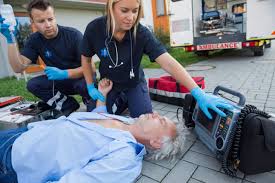Not long ago, a small group of us were out on our road bikes. One biker hit something on the road, and went down. He broke his wrist trying to brace himself (in addition to scraping himself up pretty badly). We called an ambulance, the paramedics acted quickly. They examined him. They checked to see if anything else was broken, if he was bleeding. They asked him questions like, “What day of the week is it, what’s your name, where are you right now,” checking to see if he might have hit his head, suffering some sort of brain damage. They immobilized his wrist and took him to the hospital.
As we would expect, the hospital did a much more complete examination, not just of his wrist, but of the rest of his body. They did X-rays and other tests to understand if there were other injuries. They determined in fixing his broken wrist, a few screws would be necessary. He went through the procedure they repaired his wrist. Later he went through PT and months later was back to normal, biking with us.
Each of us has some sort of similar story, either of something that’s happened to us or a friend/family member. We’ve come to learn there are several stages to addressing these kinds of issues:
- Triage, or a quick fix. These are never intended to be permanent, but only help until the issue is examined and the appropriate long term solutions are developed.
- Problem determination and correction. This is understanding the real problems, making sure we understand everything that has happened, that we are identifying the right solutions/fixes, and correcting the situation.
- Follow up reinforcement. Just fixing the problem is seldom sufficient. In the case of physical injuries, we may have to rebuild strength, adapt new practices, learn how to do things safely. In other problems, we need to do the same thing, we need to make sure we are doing the things that sustain and build our capabilities to maintain the solutions we have put in place, to build our capacity for executing these solutions, consistently.
We know this for things like physical injuries and similar issues. We know if we don’t go through these 3 stages of addressing and correcting the issues, that more serious things might happen. We might have a aggravate the problem, perhaps create a more serious issue.
We know this is the way we handle potentially “life threatening” issues. Doing anything else would be unspeakable. And this extends to “business threatening” issues. But somehow, we usually fail to do the things we know to be critical in solving these problems.
We are great at “triage,” the quick fixes, the things that enable us to get by for a short period of time. But we fail to take the time to understand the issues, to assess different solutions, to develop approaches that are more sustainable over time.
Or when we put more effective solutions in place, we fail in “business PT,” we don’t reassess, tune and reinforce those things we’ve put in place. It’s too easy to revert to the things we have always done, failing to sustain the solutions, processes we’ve identified as critical for achieving our goals.
Triage, quick fixes are not intended to be permanent. They are just quick fixes. If we want a sustainable solution, if we want to drive sustained performance, we need to move beyond quick fixes, doing the work to understand the real problems, implementing longer term solutions. We need to to the “business PT,” that enables us to sustain them afterwards.

Leave a Reply